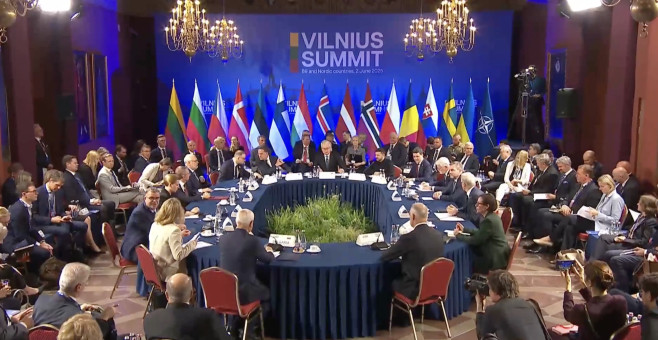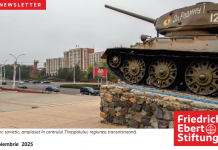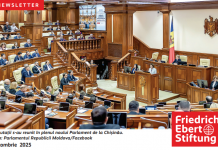The summit took place against a backdrop of ongoing Russian aggression in Ukraine, which has fundamentally altered the security landscape of Europe. Russia’s invasion has not only destabilized Ukraine but also intensified concerns about the vulnerability of NATO’s eastern member states. The B9 format, established in 2015 by Romania and Poland in response to Russia’s annexation of Crimea, has evolved into a central platform for articulating the security priorities of the eastern flank. The inclusion of Nordic countries in this summit reflects a growing recognition of the interconnectedness of security challenges across the Baltic and Black Sea regions.
The B9 Summit in Vilnius on June 2, 2025, was a defining moment for NATO’s eastern flank and for the broader Euro-Atlantic security architecture. The gathering brought together leaders from the Bucharest Nine (B9) countries—Bulgaria, Czech Republic, Estonia, Hungary, Latvia, Lithuania, Poland, Romania, and Slovakia—alongside representatives from the Nordic countries (Denmark, Finland, Iceland, Norway, and Sweden), NATO Secretary General Mark Rutte, and Ukrainian President Volodymyr Zelensky. This event, hosted by Lithuanian President Gitanas Nausėda, was designed to coordinate positions ahead of the NATO summit in The Hague later in June, but its significance extends far beyond mere preparatory discussions.
Key Outcomes and Declarations:
- Defense Spending and Military Investment
One of the most notable outcomes of the summit was the agreement to raise defense spending targets for non-American NATO allies to at least 5% of GDP. This ambitious goal, set out in the joint declaration signed by the presidents of Poland, Romania, and Lithuania, is a clear response to the persistent threat posed by Russia and the need for credible deterrence and defense capabilities. The leaders emphasized the importance of expanding and accelerating the production of military equipment, developing infrastructure, and launching joint projects to enhance collective security.
- Support for Ukraine and Moldova
The summit reaffirmed the participants’ unwavering support for Ukraine’s defense, territorial integrity, and Euro-Atlantic integration. The leaders reiterated their commitment to Ukraine’s “irreversible path” toward NATO membership, despite political headwinds in some Western capitals. This stance is particularly significant given the ongoing debate about the conditions for Ukraine’s accession and the need to avoid any perception that Russia has a veto over NATO decisions.
The summit also highlighted the importance of supporting Moldova, which faces complex risks and threats due to its proximity to the war in Ukraine.
- Romania’s Elevated Role
Romania’s participation was marked by the first international appearance of President Nicușor Dan in this capacity. President Dan positioned Romania as “the voice of the eastern flank,” underscoring the country’s commitment to collective security from the Baltic to the Black Sea. This narrative was reinforced by President Zelensky’s public acknowledgment that “Romania is very important,” a statement that carries significant weight given Ukraine’s dependence on regional allies for support. Zelensky’s invitation for President Dan to visit Ukraine further signaled the deepening of bilateral relations and strategic coordination. Romania’s strategic importance was further underscored by the announcement that it will host the next B9 summit in 2026. This decision, coupled with ongoing efforts to expand NATO’s military footprint in Romania—including the construction of Europe’s largest NATO base at Mihail Kogălniceanu and the deployment of French troops for the Dacian Spring 25 exercise—demonstrates the country’s transformation from a peripheral actor to a central player in NATO’s defense architecture.
- Broader Implications for NATO and European Security: Deterrence and Defense Posture
The summit’s focus on raising defense spending and enhancing military capabilities reflects a broader shift within NATO toward a more robust and integrated deterrence posture. The eastern flank countries, in particular, have led the way in harmonizing defense planning, standardizing equipment, and co-locating production and repair facilities. Initiatives such as the Baltic Defense Line and Poland’s East Shield are creating a continuous belt of deterrence along NATO’s eastern border, leveraging shared doctrine, logistics, and industry to raise the cost of aggression and enhance operational readiness.
- Political Unity and Alliance Cohesion
The Vilnius summit also served as a platform for reaffirming political unity in the face of Russian aggression. The joint declaration emphasized that Russia remains the most significant, long-term, and direct threat to Euro-Atlantic security and that NATO must be prepared for all eventualities. The leaders called for continued pressure on Russia through sanctions and accountability measures, and they stressed the importance of maintaining the principle that Russia has no veto over NATO decisions.
Media and Public Diplomacy Romanian journalists played a crucial role in shaping the public narrative around the summit, securing direct statements from high-profile leaders such as President Zelensky. This coverage not only informed the public but also reinforced Romania’s image as a reliable and responsible ally. The summit’s proceedings were widely covered, with live streams and official statements available to the public via NATO’s platforms.
Thus, the B9 Summit in Vilnius was a landmark event for NATO’s eastern flank and for Romania in particular. It demonstrated the growing cohesion and strategic alignment of the eastern and northern allies in response to Russian aggression. The ambitious defense spending targets, the reaffirmation of support for Ukraine and Moldova, and the elevation of Romania’s role within the alliance all point to a new era of collective security and deterrence in Europe. The summit’s outcomes will have lasting implications for NATO’s strategic priorities, the level of support extended to Ukraine and other vulnerable partners, and the alliance’s readiness to confront evolving threats. For Romania, the event was an opportunity to assert its leadership on the eastern flank and to strengthen its partnerships with both neighboring states and key allies in the West. As NATO prepares for its summit in The Hague, the Vilnius meeting has set a high bar for unity, ambition, and resolve in the face of persistent challenges to Euro-Atlantic security.







